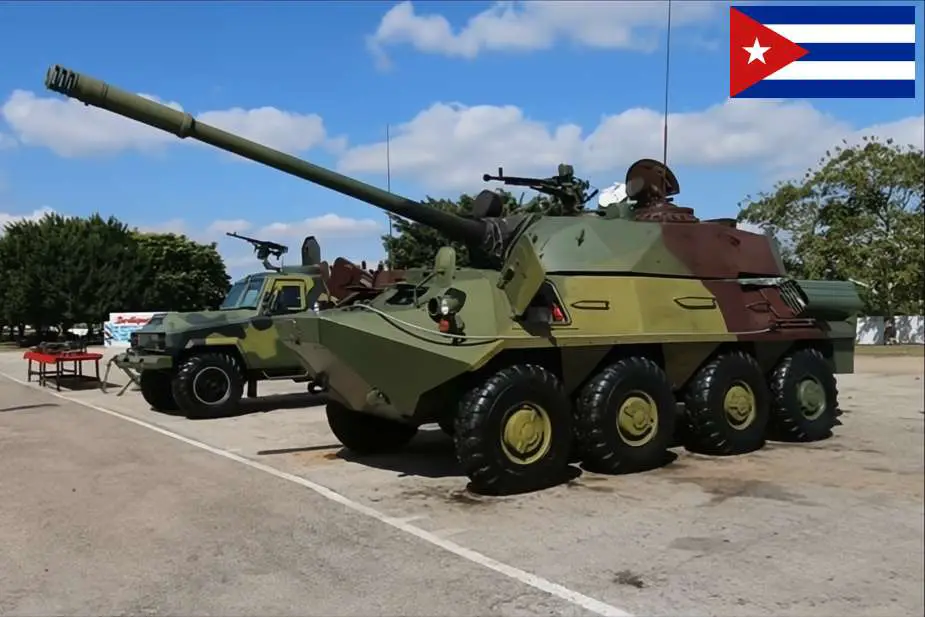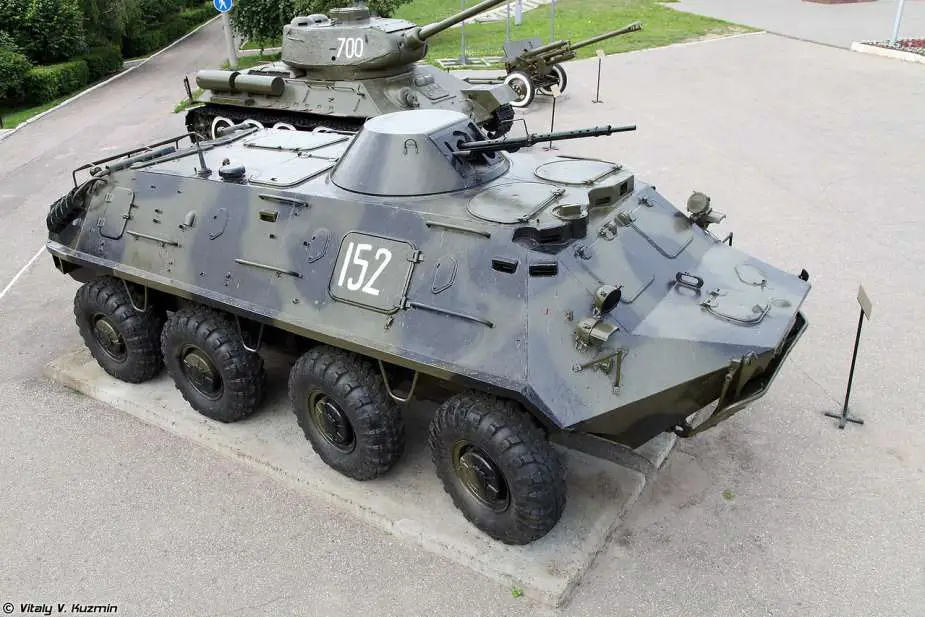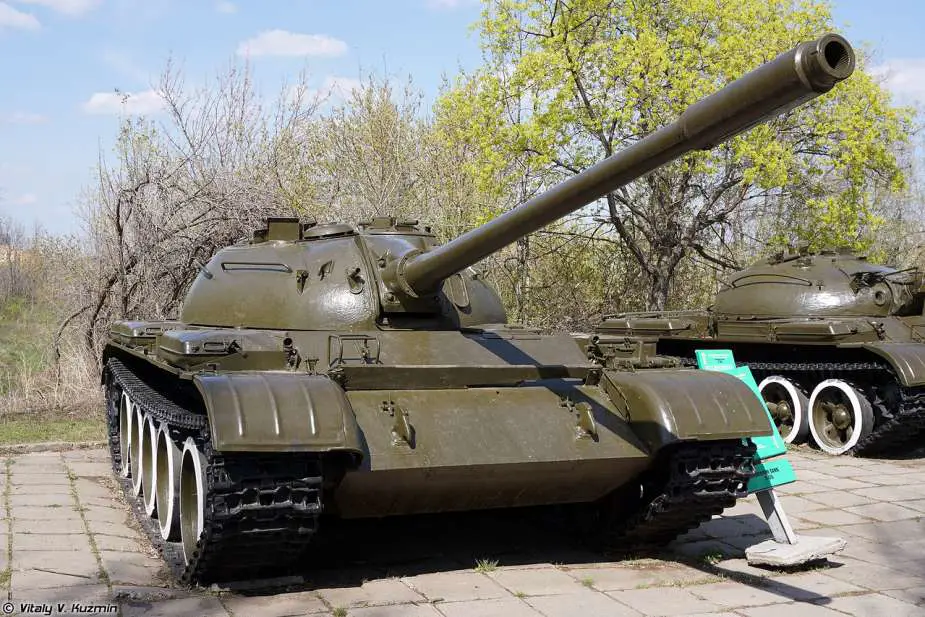On October 20, 2023, images of the Cuban BTR-100 8x8 combat reconnaissance vehicle surfaced on Russian social media platforms, shedding light on an unconventional armored vehicle that combines the chassis of the Soviet-era BTR-60 armored personnel carrier (APC) with the turret of a T-55 tank. The concept of the BTR-100, also designated as BTR-60-100, which traces its origins back to the late 1990s, emerged when the Cuban Army sought to explore the idea of a "wheeled tank" or a reconnaissance vehicle equipped with a potent 90-105 mm cannon, similar to the Italian Centauro B1 or the French AMX-10RC.
Follow Army Recognition on Google News at this link

The Cuban BTR-100 reconnaissance vehicle is based on the same concept as the French AMX-10 RC and the Italian B1 Centauro. (Picture source: Russian social media)
In Russia, for some reason, this vehicle is constantly compared with the experimental Soviet 85mm wheeled self-propelled gun 2S14 Zhalo-S based on the BTR-70. However, due to limited resources stemming from sanctions imposed by the US and the collapse of the Soviet Union, Cuba found itself constrained. The only available base for such a vehicle was the BTR-60 armored personnel carrier, which had to incorporate turrets and components from decommissioned T-55 tanks, that had been previously repurposed into anti-aircraft missile systems, such as the SA-2 and SA-3 anti-aircraft missile launchers.
The conversion of the standard BTR-60 into the BTR-100 was a complex process, as the T-55 turret was too heavy for the APC. Extensive alterations were made to both the turret and the hull to accommodate the 100 mm cannon. The central part of the turret, which housed the gun mantlet and the commander's and gunner's hatches, remained unaltered. In contrast, the front and rear sections of the turret were reconstructed using bulletproof armor. The cannon was also equipped with a new ejector and muzzle brake. Additionally, the BTR-60's interior underwent significant changes, with the removal of all navigational equipment and a comprehensive reconfiguration of logistics components. New armor panels were added to the lower part of the sides, covering the gaps between the wheels.
As a result of this transformation, the BTR-100 is armed with a 100 mm D-10T-TS2 cannon and two machine guns, including a 7.62 mm PKT coaxial machine gun mounted alongside the cannon and a 12.7 mm DShKT machine gun located on an anti-aircraft turret. Unlike the original BTR-60, the BTR-100 is not amphibious, likely due to the enhanced weight, but is highly mobile compared to the T-55 tank. It is estimated to weigh between 18 to 20 tons, to have additional bulletproof armor, and typically requires a crew of four. While the specific type of engine remains unconfirmed, some speculate that a Western-made diesel engine, likely from a commercial truck, has been installed.
The production of the BTR-100 was characterized by its small-scale nature, with re-equipment carried out in batches of only 5 to 8 vehicles at most, over the course of a decade (from 2002 to 2012).
Based on available data, at least three primary production variants of the BTR-100/BTR-60-100 are distinguishable. Note that, as the Cuban Army categorically does not accept any division of these machines by year of manufacture, series, or modifications, the names of the BTR-60-100 variants are to a certain extent arbitrary, as these names originated from foreign experts.
The first is the BTR-60-100PB-1. These are vehicles built on the basis of the BTR-60PB, in which the standard side hatches of the base armored personnel carrier have been moved to the front part of the hull to the places of the commander and driver. The exhaust pipes of this version of the BTR-60-100 are assembled into a single block and placed on one left side. This version of the BTR-60-100 has been produced since 2002 and, apparently, is the most numerous in the Cuban military forces.
The second is BTR-60-100PB-2. Vehicles are based on the BTR-60PB and are almost similar to the BTR-60-PB-1 (the side hatches were moved to the front of the hull), but with some differences in the design and location of the hatches above the hull and with two exhaust pipes located on both sides. Judging by the small number of published photographs, this modification was produced in 2008-2012 and is the smallest of all Cuban BTR-60-100s.

The Cuban BTR-100 reconnaissance vehicle is based on the Soviet BTR-60 8x8 armored personnel carrier (Picture source: Vitaly Kuzmin)
The third is BTR-60-100PA. Apparently, these vehicles were built on the basis of the earlier BTR-60PA. In any case, since armored personnel carriers of this modification initially did not have standard side hatches, there are also no side hatches at the driver's and commander's seats on the BTR-60-100PA, and instead, there are loopholes for firing small arms, according to pictures available. The top of the hull and double exhaust pipes of the BTR-60-100PA are basically designed similarly to the BTR-60-100PB-2. The Cubans produced this version of the BTR-60-100 in 2006-2009.
The limited resources have left a distinct mark on the BTR-100PB and BTR-100PA variants. This scarcity of resources is evident in the presence of openly installed headlights without covers on some of these vehicles. Notably, the earlier iterations of the BTR-100 lacked the upper hatches in the positions typically found on the BTR-60PA and BTR-60PB. This omission of upper hatches was a deliberate choice during the conversion process, as the BTR-60P, which would have been the source of these hatches, was not used in the initial transformation into the BTR-100.
The result is a degree of variability among individual vehicles, particularly in the presence or absence of headlight housings. These differences are a direct consequence of repurposing available BTR-60PA and BTR-60PB vehicles from various production years. In addition, units of even the same production batch may differ from each other in the shape, diameter, location, and method of installing the exhaust pipes and their casing (the pipes can be single or interlocked in pairs, and the casing can be faceted or rounded, perhaps due to the different types of engines used), the shape and method for the armor of the wheel arches, method, number, and location of attachment of spare parts, configuration of rear-view mirrors and other small details, such as tow hooks, radio antennas, handrails, and loophole covers.
Judging by the number of BTR-100s of both modifications demonstrated at parades in Havana, Cuba's inventory of BTR-100 vehicles includes approximately between 15 and 40 units, depending on the source. While some estimates suggest higher numbers, it is important to consider that these figures are likely exaggerated.
A single picture of an allegedly Cuban BTR-60PB fitted with the turret of a PT-76 amphibious tank also appeared, but experts came to the conclusion that this photo was nothing more than a hoax. Also untrue is the assumption that most of the ammunition of the BTR-100 is placed in the developed aft niche of the turret, especially since no photographs of the internal structure, or at least diagrams with a section of the fighting compartment of the armored personnel carrier, have yet been published. The gun is probably loaded manually, and it is believed that about 35-40 rounds are carried for the main gun.
Contrary to some misconceptions, the BTR-100 is not primarily an anti-tank vehicle for the Cuban Army. Instead, it serves as a mobile artillery reserve within Cuba's coastal defense system. This vehicle has an effective range of 1.5-2 km, and its primary ammunition load consists of high-explosive fragmentation rounds, but the gun could also fire armor-piercing and shaped-charge ammunition. The BTR-100 has certain limitations as it cannot fire while on the move and is intended for stationary or short-stop firing. Turning the turret 90 degrees requires caution due to the considerable weight of the turret and the increased height of the vehicle, which makes it prone to tipping over when firing from elevated positions, such as a hill or a road with a high embankment.
According to information from Cuban sources, most of the cannon ammunition, except for a few first-feed shots, is located in the BTR-100 hull, and the developed aft niche of the turret is used exclusively to accommodate spare parts. In addition, there is no exact information about whether the standard weapon stabilizer from the T-55 tank was retained on the BTR-100, despite the fact that the vehicle uses the TSh2B-32P sight, the TNP-165 observation device, and the TPN-1-22-11 night sight from the T-55 tank.

The Cuban Army modified multiple components from decommissioned T-55 tanks for its BTR-100 recon vehicle, including the turret and the 100mm gun. (Picture source: Vitaly Kuzmin)















